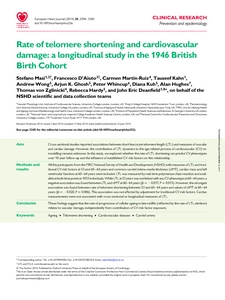Masi, S;
D'Aiuto, F;
Martin-Ruiz, C;
Kahn, T;
Wong, A;
Ghosh, AK;
Whincup, P;
Kuh, D;
Hughes, A;
von Zglinicki, T;
et al.
Masi, S; D'Aiuto, F; Martin-Ruiz, C; Kahn, T; Wong, A; Ghosh, AK; Whincup, P; Kuh, D; Hughes, A; von Zglinicki, T; Hardy, R; Deanfield, JE; NSHD scientific and data collection teams
(2014)
Rate of telomere shortening and cardiovascular damage: a longitudinal study in the 1946 British Birth Cohort.
European Heart Journal, 35 (46).
pp. 3296-3303.
ISSN 1522-9645
https://doi.org/10.1093/eurheartj/ehu226
SGUL Authors: Whincup, Peter Hynes
![[img]](https://openaccess.sgul.ac.uk/107255/1.hassmallThumbnailVersion/Rate_telomere_shortening_cardiovascular.pdf)  Preview |
|
["document_typename_application/pdf; charset=binary" not defined]
Published Version
Download (483kB)
| Preview
|
Abstract
AIM: Cross-sectional studies reported associations between short leucocyte telomere length (LTL) and measures of vascular and cardiac damage. However, the contribution of LTL dynamics to the age-related process of cardiovascular (CV) remodelling remains unknown. In this study, we explored whether the rate of LTL shortening can predict CV phenotypes over 10-year follow-up and the influence of established CV risk factors on this relationship.
METHODS AND RESULTS: All the participants from the MRC National Survey of Health and Development (NSHD) with measures of LTL and traditional CV risk factors at 53 and 60-64 years and common carotid intima-media thickness (cIMT), cardiac mass and left ventricular function at 60-64 years were included. LTL was measured by real-time polymerase chain reaction and available at both time points in 1033 individuals. While LTL at 53 years was not linked with any CV phenotype at 60-64 years, a negative association was found between LTL and cIMT at 60-64 years (β = -0.017, P = 0.015). However, the strongest association was found between rate of telomere shortening between 53 and 60-64 years and values of cIMT at 60-64 years (β = -0.020, P = 0.006). This association was not affected by adjustment for traditional CV risk factors. Cardiac measurements were not associated with cross-sectional or longitudinal measures of LTL.
CONCLUSION: These findings suggest that the rate of progression of cellular ageing in late midlife (reflected by the rate of LTL attrition) relates to vascular damage, independently from contribution of CV risk factor exposure.
| Item Type: |
Article
|
| Additional Information: |
© The Author 2014. Published by Oxford University Press on behalf of the European Society of Cardiology.
This is an Open Access article distributed under the terms of the Creative Commons Attribution Non-Commercial License (http://creativecommons.org/licenses/by-nc/4.0/), which permits non-commercial re-use, distribution, and reproduction in any medium, provided the original work is properly cited. For commercial re-use, please contact
journals.permissions@oup.com |
| Keywords: |
Ageing, Cardiovascular diseases, Carotid artery, Telomeres shortening, Cardiovascular System & Hematology, 1102 Cardiovascular Medicine And Haematology |
| SGUL Research Institute / Research Centre: |
Academic Structure > Population Health Research Institute (INPH) |
| Journal or Publication Title: |
European Heart Journal |
| ISSN: |
1522-9645 |
| Language: |
ENG |
| Dates: |
| Date | Event |
|---|
| 23 June 2014 | Published |
|
| PubMed ID: |
24957070 |
 |
Go to PubMed abstract |
| URI: |
https://openaccess.sgul.ac.uk/id/eprint/107255 |
| Publisher's version: |
https://doi.org/10.1093/eurheartj/ehu226 |
Statistics
Item downloaded times since 18 Dec 2014.
Actions (login required)
 |
Edit Item |



